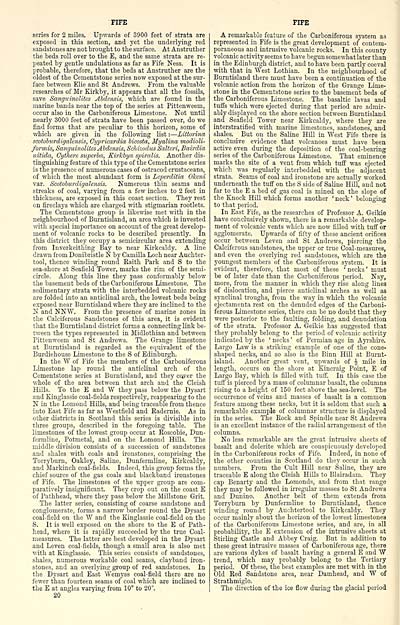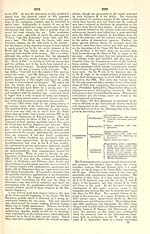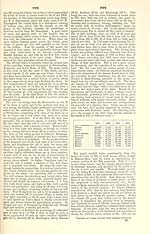Ordnance gazetteer of Scotland > Volume 3
(84) Page 20 - FIF
Download files
Complete book:
Individual page:
Thumbnail gallery: Grid view | List view

riFE
series for 2 miles. Upwards of 3900 feet of strata are
exposed in this section, and yet the underlying red
sandstones are not brought to the surface. At Anstruther
the beds roll over to the E, and the same strata are re-
peated by gentle undulations as far as Fife Ness. It is
probable, therefore, that the beds at Anstruther are the
oldest of the Cementstone series now exposed at the sur-
face between Elie and St Andrews. From the valuable
researches of Mr Kirkby, it appears that aU the fossils,
save Sanguinolitcs Abdensis, which are found in the
marine bands near the top of the series at Pittenweem,
occur also in the Carboniferous Limestone. Not until
nearly 3000 feet of strata have been passed over, do we
find forms that are peculiar to this horizon, some of
which are given in the following list : — Littorina
scotoburdigalensis, Cypricardia bicosta, Myalina modioli-
formis, Sanguinolites Abdensis, Schizodus Salteri, Bairdia
nitida, Cythere siiperba, Kirkbya sjnralis. Another dis-
tinguishing feature of this type of the Cementstone series
is the presence of numerous cases of ostracod crustaceans,
of which the most abundant form is Lcjjcrditia Okeni
var. Scotoburdigalensis. Numerous thin seams and
streaks of coal, varying from a few inches to 2 feet in
thickness, are exposed in this coast section. They rest
on fii'eclays which are charged with stigmarian rootlets.
The Cementstone group is likewise met with in the
neighbourhood of Burntisland, an area which is invested
rath special importance on account of the great develop-
ment of volcanic rocks to be described presently. In
this district they occupy a semicircular area extending
from Inverkeithing Bay to near Kirkcaldy. A line
drawn from Donibristle N by Camilla Loch near Auchter-
tool, thence winding round Raith Park and S to the
sea-shore at Seafield Tower, marks the rim of the semi-
circle. Along this line they pass conformably below
the basement beds of the Carboniferous Limestone. The
sedimentary strata with the interbedded volcanic rocks
are folded into an anticlinal arch, the lowest beds being
exposed near Burntisland where they are inclined to the
N and NNW. From the presence of marine zones in
the Calciferous Sandstones of this area, it is evident
that the Burntisland district forms a connecting link be-
tween the types represented in Midlothian and between
Pittenweem and St Andrews. The Grange limestone
at Burntisland is regarded as the equivalent of the
Burdiehouse Limestone to the S of Edinburgh.
In the "W of Fife the members of the Carboniferous
Limestone lap round the anticlinal arch of the
Cementstone series at Burntisland, and they cc^ver the
whole of the area between that arch and the Cleish
Hills. To the E and W they pass below the Dysart
and Kinglassie coal-fields respectively, reappearing to the
N in the Lomond HUls, and being traceable from thence
into East Fife as far as Westfleld and Eadernie. As in
other districts in Scotland this series is divisible into
three groups, described in the foregoing table. The
limestones of the lowest group occur at Roscobie, Dun-
fermline, Potmetal, and on the Lomond HOls. The
middle division consists of a succession of sandstones
and shales with coals and ironstones, comprising the
Torryburn, Oakley, Saline, Dunfermline, Kirkcaldy,
and Markinch coal-fields. Indeed, this group forms the
chief source of the gas coals and blackband ironstones
of Fife. The limestones of the upper group are com-
paratively insignificant. They crop out on the coast E
of Pathhead, where they pass below the Millstone Grit.
The latter series, consisting of coarse sandstone and
conglomerate, forms a narrow border round the Dysart
coal-field on the W and the Kinglassie coal-field on the
S. It is well exposed on the shore to the E of Path-
head, where it is rapidly succeeded by the true Coal-
measures. The latter are best developed in the Dysart
and Leven coal-fields, though a small area is also met
■with at Kinglassie. This series consists of sandstones,
shales, numerous workable coal seams, clayband iron-
stones, and an overlyins group of red sandstones. In
the Dysart and East Wemyss coal-field there are no
fewer than fourteen seams of coal which are inclined to
the E at angles varying from 10° to 20°.
20
FIFE
A remarkable feature of the Carboniferous system as
represented in Fife is the great development of contem-
poraneous and intrusive volcanic rocks. In this county
volcanic activity seems to have begun somewhat later than
in the Edinburgh district, and to have been partly coeval
with that in West Lothian. In the neighbourhood of
Burntisland there must have been a continuation of the
volcanic action from the horizon of the Grange Lime-
stone in the Cementstone series to the basement beds of
the Carboniferous Limestone. The basaltic lavas and
tuffs which were ejected during that period are admir-
ably displayed on the shore section between Burntisland
and Seafield Tower near Kirkcaldy, where they are
interstratified with marine limestones, sandstones, and
shales. _ But on the Saline Hill in West Fife there is
conclusive evidence that volcanoes must have been
active even during the deposition of the coal-bearing
series of the Carboniferous Limestone. That eminence
marks the site of a vent from which tuff was ejected
which was regularly interbedded with the adjacent
strata. Seams of coal and ironstone are actually worked
underneath the tuff on the S side of Saline Hill, and not
far to the E a bed of gas coal is mined on the slope of
the Knock Hill which forms another ' neck ' belonging
to that period.
In East Fife, as the researches of Professor A. Geikie
have conclusively shown, there is a remarkable develop-
ment of volcanic vents which are now filled with tuff or
agglomerate. Upwards of fifty of these ancient orifices
occur between Leven and St Andrews, piercing the
Calciferous sandstones, the upper or true Coal-measures,
and even the overlying red sandstones, which are the
youngest members of the Carboniferous system. It is
evident, therefore, that most of these ' necks ' must
be of later date than the Carboniferous period. Nay,
more, from the manner in which they rise along lines
of dislocation, and pierce anticlinal arches as well as
synclinal troughs, from the way in which the volcanic
ejectamenta rest on the denuded edges of the Carboni-
ferous Limestone series, there can be no doubt that they
were posterior to the faulting, folding, and denudation
of the strata. Professor A. Geikie has suggested that
they probably belong to the period of volcanic activity
indicated by the ' necks ' of Permian age in Ayi'shire.
Largo Law is a striking example of one of the cone-
shaped necks, and so also is the Binn Hill at Burnt-
island. Another great vent, upwards of J mile in
length, occurs on the shore at Kincraig Point, E of
Largo Bay, which is filled with tuff. In this case the
tuflf is pierced by a mass of columnar basalt, the columns
rising to a height of 150 feet above the sea-level. The
occurrence of veins and masses of basalt is a common
feature among these necks, but it is seldom that such a
remarkable example of columnar structure is displayed
in the series. The Rock and Spindle near St Andrews
is an excellent instance of the radial arrangement of the
columns.
No less remarkable are the great intrusive sheets of
basalt and dolerite which are conspicuously developed
in the Carboniferous rocks of Fife. Indeed, in none of
the other counties in Scotland do they occur in such
numbers. From the Cult Hill near Saline, they are
traceable E along the Cleish Hills to Blairadam. They
cap Benarty and the Lomonds, and from that range
they may be followed in irregular masses to St Andrews
and Dunino. Another belt of them extends from
Torryburn by Dunfermline to Burntisland, thence
winding round by Auchtertool to Kirkcaldy. They
occur mainly about the horizon of the lowest limestones
of the Carboniferous Limestone series, and are, in all
probability, the E extension of the intrusive sbeets at
Stirling Castle and Abbey Craig. But in addition to
these great intrusive masses of Carboniferous age, there
are various dykes of basalt having a general E and W
trend, which may probably belong to the Tertiary
period. Of these, the best examples are met with in the
Old Red Saiidstone area, near Damhead, and W of
Strathmiglo.
The direction of the ice flow dming the glacial period
series for 2 miles. Upwards of 3900 feet of strata are
exposed in this section, and yet the underlying red
sandstones are not brought to the surface. At Anstruther
the beds roll over to the E, and the same strata are re-
peated by gentle undulations as far as Fife Ness. It is
probable, therefore, that the beds at Anstruther are the
oldest of the Cementstone series now exposed at the sur-
face between Elie and St Andrews. From the valuable
researches of Mr Kirkby, it appears that aU the fossils,
save Sanguinolitcs Abdensis, which are found in the
marine bands near the top of the series at Pittenweem,
occur also in the Carboniferous Limestone. Not until
nearly 3000 feet of strata have been passed over, do we
find forms that are peculiar to this horizon, some of
which are given in the following list : — Littorina
scotoburdigalensis, Cypricardia bicosta, Myalina modioli-
formis, Sanguinolites Abdensis, Schizodus Salteri, Bairdia
nitida, Cythere siiperba, Kirkbya sjnralis. Another dis-
tinguishing feature of this type of the Cementstone series
is the presence of numerous cases of ostracod crustaceans,
of which the most abundant form is Lcjjcrditia Okeni
var. Scotoburdigalensis. Numerous thin seams and
streaks of coal, varying from a few inches to 2 feet in
thickness, are exposed in this coast section. They rest
on fii'eclays which are charged with stigmarian rootlets.
The Cementstone group is likewise met with in the
neighbourhood of Burntisland, an area which is invested
rath special importance on account of the great develop-
ment of volcanic rocks to be described presently. In
this district they occupy a semicircular area extending
from Inverkeithing Bay to near Kirkcaldy. A line
drawn from Donibristle N by Camilla Loch near Auchter-
tool, thence winding round Raith Park and S to the
sea-shore at Seafield Tower, marks the rim of the semi-
circle. Along this line they pass conformably below
the basement beds of the Carboniferous Limestone. The
sedimentary strata with the interbedded volcanic rocks
are folded into an anticlinal arch, the lowest beds being
exposed near Burntisland where they are inclined to the
N and NNW. From the presence of marine zones in
the Calciferous Sandstones of this area, it is evident
that the Burntisland district forms a connecting link be-
tween the types represented in Midlothian and between
Pittenweem and St Andrews. The Grange limestone
at Burntisland is regarded as the equivalent of the
Burdiehouse Limestone to the S of Edinburgh.
In the "W of Fife the members of the Carboniferous
Limestone lap round the anticlinal arch of the
Cementstone series at Burntisland, and they cc^ver the
whole of the area between that arch and the Cleish
Hills. To the E and W they pass below the Dysart
and Kinglassie coal-fields respectively, reappearing to the
N in the Lomond HUls, and being traceable from thence
into East Fife as far as Westfleld and Eadernie. As in
other districts in Scotland this series is divisible into
three groups, described in the foregoing table. The
limestones of the lowest group occur at Roscobie, Dun-
fermline, Potmetal, and on the Lomond HOls. The
middle division consists of a succession of sandstones
and shales with coals and ironstones, comprising the
Torryburn, Oakley, Saline, Dunfermline, Kirkcaldy,
and Markinch coal-fields. Indeed, this group forms the
chief source of the gas coals and blackband ironstones
of Fife. The limestones of the upper group are com-
paratively insignificant. They crop out on the coast E
of Pathhead, where they pass below the Millstone Grit.
The latter series, consisting of coarse sandstone and
conglomerate, forms a narrow border round the Dysart
coal-field on the W and the Kinglassie coal-field on the
S. It is well exposed on the shore to the E of Path-
head, where it is rapidly succeeded by the true Coal-
measures. The latter are best developed in the Dysart
and Leven coal-fields, though a small area is also met
■with at Kinglassie. This series consists of sandstones,
shales, numerous workable coal seams, clayband iron-
stones, and an overlyins group of red sandstones. In
the Dysart and East Wemyss coal-field there are no
fewer than fourteen seams of coal which are inclined to
the E at angles varying from 10° to 20°.
20
FIFE
A remarkable feature of the Carboniferous system as
represented in Fife is the great development of contem-
poraneous and intrusive volcanic rocks. In this county
volcanic activity seems to have begun somewhat later than
in the Edinburgh district, and to have been partly coeval
with that in West Lothian. In the neighbourhood of
Burntisland there must have been a continuation of the
volcanic action from the horizon of the Grange Lime-
stone in the Cementstone series to the basement beds of
the Carboniferous Limestone. The basaltic lavas and
tuffs which were ejected during that period are admir-
ably displayed on the shore section between Burntisland
and Seafield Tower near Kirkcaldy, where they are
interstratified with marine limestones, sandstones, and
shales. _ But on the Saline Hill in West Fife there is
conclusive evidence that volcanoes must have been
active even during the deposition of the coal-bearing
series of the Carboniferous Limestone. That eminence
marks the site of a vent from which tuff was ejected
which was regularly interbedded with the adjacent
strata. Seams of coal and ironstone are actually worked
underneath the tuff on the S side of Saline Hill, and not
far to the E a bed of gas coal is mined on the slope of
the Knock Hill which forms another ' neck ' belonging
to that period.
In East Fife, as the researches of Professor A. Geikie
have conclusively shown, there is a remarkable develop-
ment of volcanic vents which are now filled with tuff or
agglomerate. Upwards of fifty of these ancient orifices
occur between Leven and St Andrews, piercing the
Calciferous sandstones, the upper or true Coal-measures,
and even the overlying red sandstones, which are the
youngest members of the Carboniferous system. It is
evident, therefore, that most of these ' necks ' must
be of later date than the Carboniferous period. Nay,
more, from the manner in which they rise along lines
of dislocation, and pierce anticlinal arches as well as
synclinal troughs, from the way in which the volcanic
ejectamenta rest on the denuded edges of the Carboni-
ferous Limestone series, there can be no doubt that they
were posterior to the faulting, folding, and denudation
of the strata. Professor A. Geikie has suggested that
they probably belong to the period of volcanic activity
indicated by the ' necks ' of Permian age in Ayi'shire.
Largo Law is a striking example of one of the cone-
shaped necks, and so also is the Binn Hill at Burnt-
island. Another great vent, upwards of J mile in
length, occurs on the shore at Kincraig Point, E of
Largo Bay, which is filled with tuff. In this case the
tuflf is pierced by a mass of columnar basalt, the columns
rising to a height of 150 feet above the sea-level. The
occurrence of veins and masses of basalt is a common
feature among these necks, but it is seldom that such a
remarkable example of columnar structure is displayed
in the series. The Rock and Spindle near St Andrews
is an excellent instance of the radial arrangement of the
columns.
No less remarkable are the great intrusive sheets of
basalt and dolerite which are conspicuously developed
in the Carboniferous rocks of Fife. Indeed, in none of
the other counties in Scotland do they occur in such
numbers. From the Cult Hill near Saline, they are
traceable E along the Cleish Hills to Blairadam. They
cap Benarty and the Lomonds, and from that range
they may be followed in irregular masses to St Andrews
and Dunino. Another belt of them extends from
Torryburn by Dunfermline to Burntisland, thence
winding round by Auchtertool to Kirkcaldy. They
occur mainly about the horizon of the lowest limestones
of the Carboniferous Limestone series, and are, in all
probability, the E extension of the intrusive sbeets at
Stirling Castle and Abbey Craig. But in addition to
these great intrusive masses of Carboniferous age, there
are various dykes of basalt having a general E and W
trend, which may probably belong to the Tertiary
period. Of these, the best examples are met with in the
Old Red Saiidstone area, near Damhead, and W of
Strathmiglo.
The direction of the ice flow dming the glacial period
Set display mode to: Large image | Transcription
Images and transcriptions on this page, including medium image downloads, may be used under the Creative Commons Attribution 4.0 International Licence unless otherwise stated. ![]()
| Gazetteers of Scotland, 1803-1901 > Ordnance gazetteer of Scotland > Volume 3 > (84) Page 20 - FIF |
|---|
| Permanent URL | https://digital.nls.uk/97377462 |
|---|
| Attribution and copyright: |
|
|---|---|

